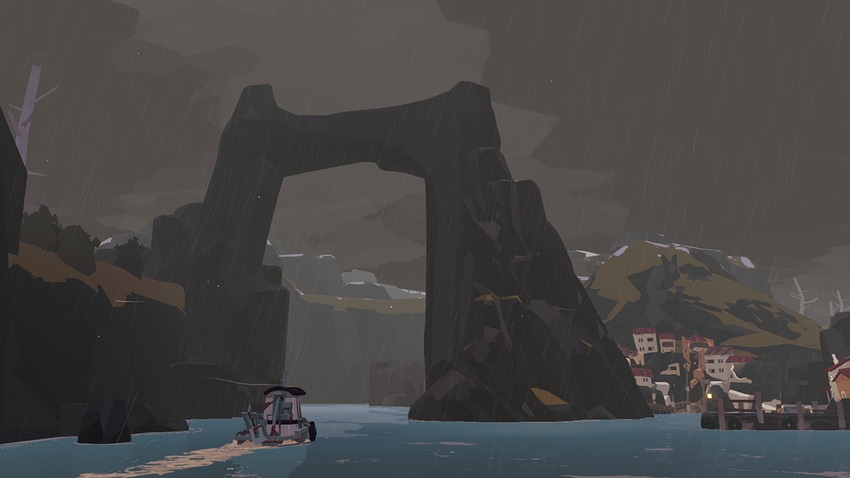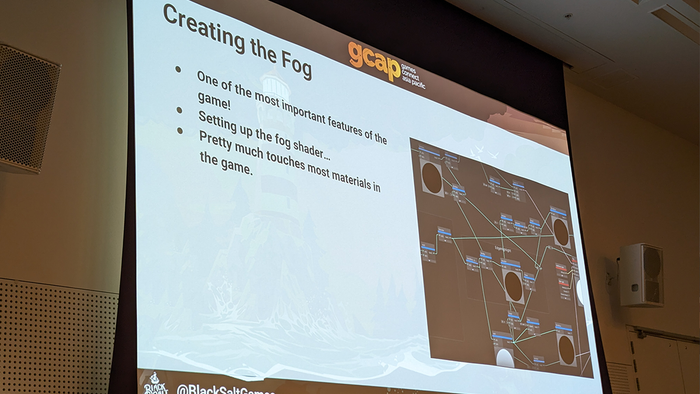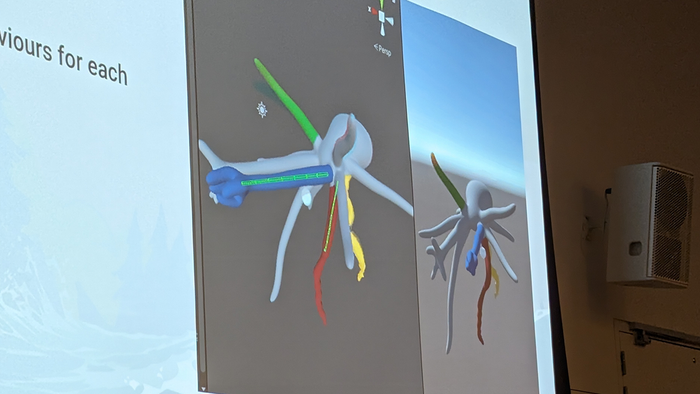Turning players' worst fears against them in Dredge
"We felt that the longer we could keep things unknown or unpredictable, the better."

Dredge is an eldritch fishing adventure that succeeds in feeling both serene and deeply unnerving thanks to some smart design choices by developer Black Salt Games. Taking to the stage at GCAP 2023 to explain how the team achieved that feat, the studio's 3D art director Michael Bastiaens says they intentionally sought to make Dredge "unsettling" rather than leaning into full-blown "jump scare" horror.
"We wanted to leave things to the player's imagination more than anything else, because it felt like people came up with the weirdest conjurations in their own mind before we'd even introduced the monsters or any of the scary events," explains Bastiaens. "Once you actually start seeing the monsters, they almost lose their impact. So we had to do a lot of things to keep those experiences fresh or put a twist on them."
The brighter the day, the darker the night
One way the team sought to slowly turn 'cozy' into 'creepy' was to make Dredge's daytime segments incredibly peaceful and disarming, which provides a stark contrast to the title's uneasy moonlit voyages.
"The game is fundamentally broken into juxtapositions as a whole, whether it be in gameplay or visual design," says Bastiaens. "Take the idea of night versus day where we have this idea of open versus closed. So, during the day, you're seeing lots of open vistas, and then at night, everything becomes incredibly claustrophobic once the fog comes in."
Bastiaens notes those vistas are almost always peaceful and vibrant, and says the team ensured that running into "bad things" during the day would be a rarity. That helped create a sense of security, which the team realized could be exploited to encourage players to stay out longer than intended.
"We didn't actually plan on people being drawn into the calm and peaceful world as much as they did, which was a really good surprise for us and really helpful for us as far as gameplay went going forwards," continues Bastiaens. "We needed people to get relaxed and immersed in our world more than anything else in order to lure them into staying out a little bit longer than expected."
When the night finally comes for players, the team sought to amplify their subconscious fears by toying with the notion of the unseen. As Bastiaens mentioned earlier, that meant impairing one of their key senses by essentially weaponizing fog. "The fog does quite a lot, especially early on when you don't have a lot of lights [on your boat]. It really is quite limiting in terms of being able to see how far you're going," says Bastiaens. "One of the interesting things was actually setting up this fog shader, because the default Unity fog shader is quite limiting and we needed to make sure fog was centered around the player and not the camera."
Bastiaens explains the fog shader touches most of the materials in Dredge and that means the game is always taking it into account. As a result, the team had to ensure it was interacting appropriately with each of those elements to ensure the "fade off" effect would actually work.

To maintain that sense of the unknown, the team was also careful to keep some of its biggest scares under wraps. Each biome in Dredge has its own unique monster that players will need to overcome, and there are some other terrors that unfortunate travelers can also encounter on the high seas. As Bastiaens noted earlier, however, revealing them too quickly would only lessen their impact, so patience was imperative.
"We slowly introduce the player to these things as they go. At the very start of the game, you're very unlikely to encounter all of the big scary things. It's only as you progress through the game you'll encounter those creatures. We felt that the longer we could keep things unknown or unpredictable, the better," says Bastiaens.
Fortunately, the ocean is a big place. There's plenty of room to hide all manner of aberrations in the endless deep, but when it came to actually making their grand reveal, the team hit a snag.
"We noticed we had some pretty big creatures, but when they sit below the water you sometimes couldn't see them at all," explains Bastiaens. To create a workaround, the team build a slider that essentially refracted a creature to fake its visibility and create the appearance of a monster rising from the depths when, in reality, it was completely static.
It's a little piece of development magic that highlights two of Black Salt's key learnings from Dredge. First, you need to figure out the mood and atmosphere you want to showcase and seek to truly understand those elements (i.e. unsettling versus horror). Then, you need to acknowledge your technical or timeline constraints as you work to realize that vision. Bastiaens explains there were a myriad of creatures (including a flailing bioluminescent octopus you can see below) the team had to cut to avoid scope creep after realizing the pitch was simply too complicated.

During those moments, Bastiaens says the team would be really honest and ask themselves whether they could make something simpler. It's not defeatist to reduce your workload, and it's a mindset that actually allowed the team to iterate and test quickly, which, for Bastiaens, is crucial.
"The sooner you can get things in and get people [playing] it, the better," he says. "So playtest things, get people looking at things, and then get feedback."
Game Developer was invited to GCAP and Melbourne International Games Week by Creative Victoria, which covered flights and accommodation.
Read more about:
FeaturesAbout the Author(s)
You May Also Like













